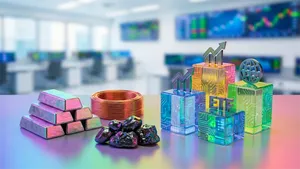
As of September 29, 2025, the global financial markets are witnessing a dramatic surge in copper prices, driven by an unprecedented confluence of tightening supply, robust demand from the burgeoning green energy transition, and various geopolitical and economic factors. This rally has propelled the red metal to near-record levels, solidifying its moniker as "new gold" and signaling a period of sustained high costs and market volatility with far-reaching implications for industries worldwide. The immediate impact is a scramble for supply, escalating production costs for manufacturers, and a re-evaluation of investment strategies across the commodity landscape.
The Red Metal's Relentless Ascent: A Deep Dive into the Price Surge
Copper prices have demonstrated remarkable resilience and upward momentum throughout 2024, intensifying into 2025. On September 29, 2025, copper futures climbed above $4.75 per pound, reaching $4.86 USD/Lbs, a 3.06% increase from the previous day. The London Metal Exchange (LME) saw copper settle at $10,181.50 per ton in late September, with broader monthly data indicating prices around $9,200 per metric ton earlier in the month, having peaked near $9,600 in the summer. Year-to-date, copper prices have jumped approximately 18%, reaching an all-time high of US$5.94 per pound in July 2025.
This relentless ascent is fueled by a severe supply-demand imbalance. On the supply side, the market has been hit by significant disruptions. A fatal mudflow incident at Freeport-McMoRan's Grasberg mine in Indonesia, a crucial source accounting for 3-4% of global mined copper, led to a force majeure declaration in September 2025, removing an estimated 250,000+ tonnes from 2025 output, with full recovery not expected before 2027. Simultaneously, Hudbay Minerals Inc. (NYSE: HBM) temporarily suspended operations at its Constancia mine in Peru due to social unrest on September 23, 2025. Adding to the crunch, China, a major producer, reduced refined copper production by 5% in early September. These immediate setbacks compound structural limitations within the mining industry, such as declining ore grades, chronic underinvestment in new projects (which take over 15 years from discovery to production), aging infrastructure, water scarcity, and persistent labor disputes.
On the demand side, the global push towards decarbonization and technological advancements is creating an insatiable appetite for copper. Electric vehicles (EVs) require two to four times more copper than traditional cars, with EV demand for copper projected to reach 1.2 million tonnes by 2025. Copper is also essential for solar cells, wind turbines, battery storage, and the massive power grids needed to support these green technologies. Furthermore, the rapid expansion of Artificial Intelligence (AI) data centers and other digital infrastructure is emerging as a significant new demand driver. Macroeconomic factors, including persistent inflationary pressures, rising energy costs, and a weaker US dollar making dollar-priced commodities more attractive, are also contributing to the upward price pressure. Initial market reactions have been characterized by bullish investor sentiment, increased volatility, and "panic buying" among traders, particularly in response to tariff threats that led to the movement of above-ground copper stocks into US-based facilities.
Shifting Fortunes: Winners and Losers in the Copper Boom
The escalating price of copper creates a clear divide among publicly traded companies, with mining operations generally reaping substantial benefits, while manufacturers heavily reliant on copper face mounting cost pressures.
The Beneficiaries: Copper Mining Giants
Copper mining companies are direct winners, as higher commodity prices translate into increased revenues and expanded profit margins. Their stock performance typically mirrors copper's upward trajectory. BHP Group (NYSE: BHP, ASX: BHP), the world's largest copper producer with significant operations at Chile's Escondida mine, is well-positioned to capitalize on the rally. Similarly, Southern Copper Corporation (NYSE: SCCO), with the industry's largest copper reserves in investment-grade countries like Mexico and Peru, stands to benefit significantly. Rio Tinto Group (NYSE: RIO), another diversified mining giant with substantial copper assets, has seen its shares jump. Teck Resources (NYSE: TECK), a Canadian miner, is noted for its strong copper leverage and growth opportunities, including its Quebrada Blanca mine in Chile. Anglo American (LON: AAL) is another top pick in the sector, expected to benefit from market deficits and higher prices, especially following its agreement with Codelco to merge operations at Los Bronces and Andina copper mines in Chile. While Freeport-McMoRan Inc. (NYSE: FCX), a major global player, faced a temporary stock decline due to the Grasberg mine incident, analysts maintain a bullish long-term outlook for the company given copper's essential role in the energy transition. Other companies like Capstone Copper Corp (ASX: CSC), Sandfire Resources Ltd (ASX: SFR), and Hillgrove Resources Ltd (ASX: HGO) are also poised for appreciation.
The Challenged: Copper-Intensive Industries
Conversely, industries that depend heavily on copper as a raw material face significant challenges. Increased input costs can erode profit margins or force companies to pass on higher costs to consumers, potentially impacting demand. Automotive manufacturers, particularly EV producers like Tesla (NASDAQ: TSLA), Ford (NYSE: F), General Motors (NYSE: GM), and Volkswagen (FWB: VOW3), are highly vulnerable. EVs require significantly more copper, directly increasing production costs and threatening to flatten profit margins or necessitate higher vehicle prices, which could dampen adoption rates. Automakers are exploring material substitution (e.g., aluminum), supply chain optimization, and enhanced recycling to mitigate these impacts. Cable and wire manufacturers, where copper can account for 62-85% of raw material expenses, are also severely impacted. Indian companies such as Polycab India, Finolex Cables, KEI Industries, and RR Kabel face immense pressure on margins, typically with a one-to-two-quarter lag in passing on costs. Electronics manufacturers and construction companies, both heavy copper users, will also encounter component shortages and higher material costs, affecting profitability and potentially increasing prices for end products.
The renewable energy sector, encompassing companies like First Solar (NASDAQ: FSLR), Enphase Energy (NASDAQ: ENPH), and Vestas Wind Systems (CPH: VWS), presents a complex case. While they are major drivers of copper demand, they are also significant consumers. Renewable energy systems typically use 5-10 times more copper per megawatt than conventional power generation. Higher copper prices directly increase the cost of producing solar panels, wind turbines, and associated grid infrastructure, potentially slowing deployment rates or requiring higher subsidies if costs cannot be absorbed or passed on.
Beyond the Immediate: Broader Significance and the "New Gold" Paradigm
The surging copper price is more than a fleeting market anomaly; it represents a fundamental shift with profound implications for global economic trends, inflationary pressures, and strategic policy considerations, firmly establishing copper's role as "new gold."
This trend is deeply intertwined with major global economic transformations, primarily the accelerated push towards decarbonization and electrification. Copper's exceptional conductivity makes it indispensable for renewable energy (solar, wind), electric vehicles, charging infrastructure, and the expansion of electrical grids. Each EV requires significantly more copper than traditional cars, and global EV production is projected to exceed 30 million units annually by the end of the decade. Furthermore, the burgeoning demand from AI and hyperscale data centers adds another layer of structural demand. This escalating demand, coupled with persistent supply constraints—including geological challenges, underinvestment, and recent operational disruptions—creates a critical supply-demand imbalance projected to intensify for years.
The impact on global inflation is direct and tangible. As a fundamental industrial metal, copper is a critical component across numerous sectors. Its rising price directly increases the cost of producing a wide range of goods and services, contributing to "cost-push" inflation. The International Monetary Fund (IMF) has already forecasted high global inflation for 2025, and copper's elevated price is a significant factor in the Consumer Price Index (CPI). This inflationary pressure can prompt central banks to re-evaluate interest rate policies, as seen with recent discussions in Australia influenced by hotter-than-expected inflation reports.
Regulatory responses, as of September 2025, are largely focused on the supply side. Existing environmental regulations and sustainability protocols in major producing nations like Chile and Peru, while crucial for responsible mining, can inadvertently limit production expansion and increase operational costs. There's no widespread evidence of new regulatory measures specifically designed to curb or control high copper prices directly. Instead, the focus appears to be on navigating the existing regulatory landscape, encouraging technological innovations to enhance efficiency, and exploring material substitution or increased recycling.
Historically, copper prices have served as a leading indicator of economic activity, earning it the nickname "Dr. Copper." The current supercycle draws parallels with previous booms driven by US industrialization, post-WWII reconstruction, and China's modernization in the early 2000s. However, this cycle is distinguished by the unprecedented scale of demand from energy transition sectors, already low global copper inventory levels, and the amplification of price responses due to greater financialization of copper markets.
The moniker "new gold" underscores copper's rising strategic importance. Unlike gold, which traditionally serves as a safe-haven asset, copper's status as "new gold" highlights its critical function as an industrial metal essential for modern development. Its vital role in EVs, renewable energy infrastructure, expanding grids, and advanced digital technologies positions it as a cornerstone metal for the future global economy. This implies a potential paradigm shift where copper's value is increasingly tied to the structural demands of a decarbonizing and electrified world, making its supply and price directly influential on the pace and cost of the global transition.
The Road Ahead: Navigating Copper's Future Landscape
The future outlook for copper prices points towards continued appreciation in both the short and long term, albeit with periods of volatility, compelling industries to adapt through innovation, diversification, and a greater emphasis on resource efficiency and recycling.
In the short term (coming months and into 2026), copper prices are expected to remain elevated or see further increases. The impact of recent supply disruptions, particularly from the Grasberg mine, will continue to tighten the market, reducing global production estimates for 2025 and 2026. Resilient demand from the energy transition, EVs, and digital technologies, especially from China's continued urbanization and green grid expansion, will maintain upward pressure. Market tightness is reflected in analyst revisions, with some projecting prices to reach $10,200-$10,500 by year-end 2025 and potentially $13,500-$14,300/ton by 2026. Geopolitical factors and trade policies, such as the initial US tariff announcements on copper imports, can also induce significant short-term volatility.
The long-term outlook for copper prices is overwhelmingly bullish, driven by the structural shifts in global energy and technology. The energy transition supercycle means demand from green technologies is projected to grow at a Compound Annual Growth Rate (CAGR) of 10.7% to 2034, with overall global refined copper demand nearly doubling by 2035. This demand will continue to outstrip supply, as new copper mines typically require 7-10 years from discovery to production, making rapid supply responses challenging. Bullish price projections from institutions like Citigroup and Bank of America suggest copper could reach US$12,000 by 2026 and potentially US$15,000 per tonne by 2027.
Industries reliant on copper will require strategic pivots. This includes innovation in material usage to reduce copper intensity or explore alternatives, accelerated recycling efforts to augment supply, and diversification of supply chains to mitigate geopolitical or environmental risks. Increased domestic production and nearshoring, driven by geopolitical motivations, could also lead to investments in local mining and smelting capacity. Businesses will also need robust cost management strategies and efficiency improvements to maintain margins.
Market opportunities abound in the growth of green technologies, digitalization, AI infrastructure, and traditional infrastructure spending. Significant opportunities also exist in technological innovation in mining and increased investment in advanced recycling infrastructure. However, challenges are equally substantial: persistent supply deficits, geological and operational constraints, long project timelines, high capital intensity, stricter environmental regulations, and geopolitical risks. Potential scenarios range from a highly bullish outcome with surging prices due to demand outstripping constrained supply, to a more cautious base case with gradual price appreciation, and even a bearish scenario triggered by a severe global economic recession. The "Rocky Road" scenario from S&P Global projects severe and long-lasting supply shortfalls, forcing both supply and demand-side reactions.
Copper's Enduring Impact: A Market Watch for Investors
The current copper market signifies a structural shift towards prolonged tightness, with periods of significant volatility. This has profound and lasting impacts, reshaping industrial strategies and global economic dynamics.
Key Takeaways: The market is fundamentally tight, driven by severe supply disruptions (e.g., Grasberg mine incident, Hudbay's Constancia suspension, China's production cuts) and accelerating demand from the energy transition (EVs, renewables) and digital technologies (AI data centers). Depleted inventories on exchanges like the LME, coupled with market backwardation, signal immediate supply stress. Macroeconomic factors and geopolitical developments, including potential US tariffs, further complicate the landscape.
Market Assessment Moving Forward: The long-term outlook remains overwhelmingly bullish, with most analysts projecting tight conditions and significant price appreciation for at least the next 3-5 years. Goldman Sachs, Bank of America, and others foresee copper prices well above current levels, potentially reaching $15,000 per tonne in the coming years. However, J.P. Morgan offers a more cautious near-term view, anticipating a slight slide before stabilization. Global mine production from existing assets is expected to peak soon, with new committed projects insufficient to meet projected demand, leading to a potential 30% shortfall by 2035 if no new actions are taken.
Lasting Impact of Elevated Copper Prices: Elevated prices will continue to incentivize new mining investment, but long lead times and increasing costs mean significant supply increases are unlikely in the short to medium term. This will lead to increased material costs and potential project delays for critical industries like renewable energy and EV manufacturing, with warnings from the IEA about potential increases in battery pack prices. The construction and electronics sectors will also face higher costs. The power industry, heavily reliant on copper for cables, will see rising infrastructure construction costs, potentially inhibiting grid upgrades. This environment will accelerate technological innovation in material utilization, substitution, and recycling, leading to long-term shifts in industrial practices. Ultimately, a sustained copper shortage poses a significant risk to the global energy transition and wider economic stability.
What Investors Should Watch For in Coming Months: Investors should closely monitor several key indicators:
- Mine Production and Disruptions: Track operational updates from major mines, especially regarding the recovery of Grasberg and any new disruptions in key producing regions.
- Inventory Levels: Observe real-time exchange inventory levels on the LME, COMEX, and SHFE for signs of persistent physical tightness.
- Chinese Economic Data: China's industrial output, manufacturing PMI, and import figures are crucial for gauging demand.
- Energy Transition Momentum & AI Infrastructure: Monitor global developments in EV sales, renewable energy project deployments, and investments in AI data centers.
- Macroeconomic and Geopolitical Developments: Pay attention to global economic growth forecasts, central bank monetary policies (especially interest rates influencing the US dollar), and geopolitical tensions, including any adjustments to US tariff policies.
- Treatment and Refining Charges (TC/RCs): Falling TC/RCs can indicate a tighter copper concentrate market, foreshadowing future refined copper shortages.
- Mining Company Performance: Review earnings reports and operational updates from major copper mining companies for insights into future supply.
The copper market is at a pivotal juncture. While the demand-side fundamentals are exceptionally strong, the supply side faces significant structural and operational hurdles. This imbalance points towards a future of higher copper prices, compelling industries to adapt and creating a dynamic, yet potentially volatile, landscape for investors.
This content is intended for informational purposes only and is not financial advice

















